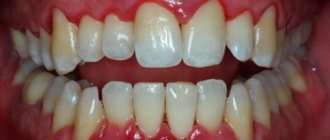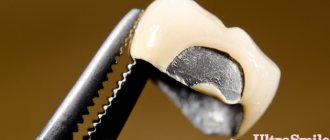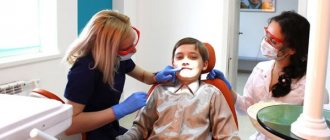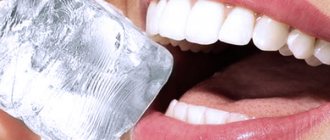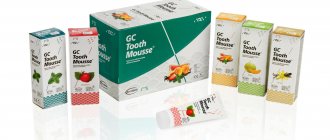From this article you will learn:
- what is hyperesthesia,
- causes and provoking factors,
- treatment of dental hypersensitivity.
Increased sensitivity of teeth is a condition in which, in response to various temperature, chemical and mechanical stimuli, short-term pain occurs in the teeth. As a rule, pain occurs in response to cold water or air, to sour, sweet or salty foods, as well as in response to the touch of the bristles of a toothbrush to the necks of the teeth. The intensity of the pain syndrome can range from mild discomfort to severe pain, which prevents you from eating or brushing your teeth.
In dentistry, the terms “hypersensitivity” or “dental hyperesthesia” are also used to refer to this condition. Human teeth are prone to hypersensitivity due to several factors. One of the main factors is the process of demineralization of tooth enamel, i.e. when, as a result of calcium being washed out of it, the surface layer of enamel becomes less dense. Usually this process occurs in the area of the necks of the teeth, where the enamel is already quite thin.
Another factor causing the development of hyperesthesia is the thinning of tooth enamel. Its thickness may decrease as a result of abrasion, or as a result of the formation of wedge-shaped defects in the area of the necks of the teeth. When tooth enamel becomes thinner or less dense, irritants begin to act through the tooth enamel on dentin, which consists of dentinal tubes with fluid circulating through it. When exposed to irritants, the speed of fluid movement in the tubes increases, which leads to irritation of the nerve endings present in them and the occurrence of pain.
Causes of tooth sensitivity
Hyperesthesia is the result of thinning or damage to the tooth enamel and its hard tissues, which leads to exposure of the tubules of the dentinal layer, which directly communicate with the pulp and nerves of the tooth. As a result of this, the slightest external impact on the tooth and its exposed tubules causes pain and discomfort.
Thinning or damage to tooth enamel occurs under the influence of internal and external factors. The main causes of this pathology are the following disorders and diseases.
- An unbalanced diet, depleted in vitamins and minerals.
- Hormonal disorders or uncontrolled use of hormone-containing drugs.
- Frequent infectious diseases.
- Chronic diseases of the gastrointestinal tract.
- Chronic stress or nervous disorders.
- Malocclusion.
- Abuse of foods high in acids.
- Use a toothbrush with stiff bristles.
- Do-it-yourself teeth whitening with dubious preparations.
- Pathological increased abrasion of tooth tissues.
- Wedge-shaped dental defects.
- Caries, periodontitis, pulpitis or erosion of tooth enamel.
- Bad habits - smoking, chewing hard nuts, grinding teeth, etc.
- Previously performed dental procedures - whitening, tartar removal, filling, prosthetics, etc.
In order to effectively relieve increased tooth sensitivity, it is necessary to accurately determine the cause of the pathology. Only by eliminating it can you get rid of pain, discomfort and other unpleasant sensations.
Reasons for the manifestation of anxiety symptoms
Hypersensitivity (hyperesthesia) is what dentists call increased excitability of hard dental tissues. With this disease, a person experiences not only discomfort, but also pain, which greatly complicates everyday life and interferes with enjoying simple joys.
Such deviations are usually the result of a number of specific factors:
- excessively intensive cleaning, too much pressure on the brush;
- an abundance of harmful bacteria in the oral cavity, which leads to the formation of plaque;
- various dental diseases: increased abrasion of the enamel layer, malocclusion, caries, inflammatory process, severe periodontitis, etc.;
- use of unsuitable products for regular oral hygiene: abrasive pastes, hygiene instruments with hard bristles;
- frequent whitening;
- long-term use of antibiotics and other drugs that affect teeth;
- poor nutrition, lack of necessary vitamins and microelements in the diet;
- harmful tendencies (tobacco smoking, constant habit of gnawing nuts and seeds);
- addiction to salty, sour and spicy foods (citrus fruits, orange juice, carbonated drinks), which destroys the enamel and makes it porous;
- hormonal imbalances;
- grinding and mechanical damage;
- old or defective fillings.
It’s worth remembering all of the above reasons when figuring out what to do if you have high tooth sensitivity and how to relieve discomfort at home.
Consequences of the whitening procedure
Quite often, hyperesthesia is a consequence of whitening procedures. Most patients report discomfort that occurs almost immediately. It is noteworthy that this happens not only as a result of inept actions at home, but also after the provision of services by qualified specialists.
Of course, if cleansing is carried out in the Dentiki dental office, the risk of hypersensitivity is minimized. After all, our doctors know well which cleaning method will be most suitable for the client. In addition, he first eliminates all existing problems in the oral cavity, and only then begins whitening. Afterwards, the doctor must carry out procedures to strengthen the weakened enamel layer.
Those who decide to whiten their teeth at home are at much greater risk. Incorrectly selected abrasive products, if used incorrectly, lead to mechanical injuries and destruction of enamel. And of course, few people think that before using whitening compounds it is necessary to eliminate any pathological manifestations in the mouth.
When reviewing information online on how to get rid of tooth sensitivity and reduce discomfort at home, it is important to understand that even when the procedure is performed by a specialist, negative manifestations cannot be completely excluded. In any case, the enamel layer becomes porous, the dentinal tubules open, which leads to unpleasant and even painful sensations. To calm pain and eliminate other symptoms, dentists recommend using special restorative and strengthening agents. They normalize the mineral composition of the enamel and saturate it with fluoride.
If you want whitening to be as safe as possible and to avoid hypersensitivity after it, follow a few rules:
- It is better to entrust the procedure to a professional.
- When planning to whiten teeth at home, use only specialized products recommended by your dentist. Do not overuse abrasive pastes.
- First get rid of any dental pathologies and put your oral cavity in order.
- Carry out manipulations aimed at strengthening the enamel layer at least 2 weeks before cleaning. Spend the same amount of time recovering after.
As a result of filling
When trying to find out what helps with tooth sensitivity, how to relieve and how to reduce discomfort, you should remember that hyperesthesia often makes itself felt immediately after visiting the dentist’s office. And it’s not just about whitening anymore. Discomfort may also occur when the patient has had a filling installed. Don't worry - this is normal. With the condition that gradually the unpleasant symptom weakens, and after about 7-10 days it disappears completely.
Hypersensitivity can also be a consequence of depulpation. This is how dental tissues and the oral cavity as a whole react to therapeutic manipulations and medications used. At the same time, if unpleasant sensations continue to disturb you for a long period of time, a medical error cannot be ruled out. This situation is a serious reason to visit the dentist’s office again and tell him about your problem.
During pregnancy
This is by far the most beautiful moment in every woman’s life is associated with numerous difficulties. In particular, representatives of the fair sex who are carrying a fetus often exhibit hyperesthesia. This happens as a result of increased stress on the body, hormonal imbalances, metabolic disorders and decreased immunity.
While studying available materials, how to soothe sensitive teeth and what to do at home, know that you cannot ignore alarming manifestations. Getting rid of pain and discomfort on your own is very difficult and often unsafe. Especially considering the position of the expectant mother. When pathology is discovered during pregnancy, you must immediately contact a specialist. Only an experienced dentist will be able to prescribe appropriate therapy and a course of health procedures.
Ideally, the condition of dental elements should be taken care of at the stage of maternity planning. Accustom yourself to preventive procedures, eat right, and don’t be afraid to visit the dental office once again. It is necessary to introduce into the diet foods enriched with vitamins C and D, magnesium and calcium.
As a reaction to hot and cold
This is the first sign of hypersensitivity. The range of sensations in this case can be different, from sharp, bright pain in one point, which quickly disappears, to a prolonged pain syndrome of a weak nature in several at once. Manifestations can be caused by minor thinning of the enamel layer or more serious pathological processes. This is why you should not put off going to the doctor. Only a professional will be able to understand the problem and recommend effective methods for eliminating hyperesthesia. If a pathology is discovered, the doctor will carry out appropriate treatment, and he will decide what to do and how to treat highly sensitive teeth only after examining the patient.
Symptoms of sensitivity
The main sign of hyperesthesia is short-term toothache, which appears when eating cold, hot, sour, sweet, spicy food or when brushing your teeth. In this case, the pain can be mild and manifest itself in the form of minor discomfort, or it can be acute, very strong and throbbing. In both cases, it is felt for only a few seconds, after which it subsides and passes without a trace.
The pain that occurs with severe sensitivity can be local and affect only one or a few teeth, or be generalized - felt in most teeth or in all at once, which indicates the presence of caries, periodontal disease or exposure of the neck of the tooth.
According to clinical manifestations, it is customary to distinguish between three degrees of increased sensitivity of teeth.
- I degree – reaction of teeth to external temperature stimuli.
- II degree – reaction to temperature and chemical stimuli.
- III degree – reaction to temperature, chemical and tactile stimuli.
Pain is a constant companion of hyperesthesia and its main symptom. And even if it goes away for a while, and the patient can calmly eat cold, hot and other irritating foods, this does not mean that tooth sensitivity has gone away by itself. In this case, a peculiar period of remission has simply begun, which does not at all negate the mandatory treatment of the pathology.
Content
- Causes of hyperesthesia
- Symptoms
- Diagnostics
- How to treat hyperesthesia?
- Independent methods of dealing with sensitivity
- Traditional methods
- Treatment at the dentist
- The effect of whitening on teeth sensitivity
- The effect of filling on sensitivity
- Reaction to thermal influence
- Prevention
Hyperesthesia is a reaction of teeth to irritants. If in a normal state a person inhales cool air painlessly, takes hot food, eats ice cream, drinks sweet soda, then with increased sensitivity these simple things cause a lot of trouble.
Treatment at home
At home, you can use special medicinal varnishes, gels, powders or foams that help restore the protective properties of the enamel. Depending on the form of release, these products are applied to the surface of the teeth or used to prepare a solution for rinsing.
- Varnish Bifluoride 12.
- Fluocal gel or solution.
- The drug Fluorlak.
- Powder for preparing Remodent solution.
- Strontium chloride paste 75% or its 25% rinse solution.
- 10% calcium gluconate solution.
- Dental gel Tooth Mousse.
- Dental cream MI Paste Plus.
These products help reduce tooth sensitivity caused by internal disturbances in the body and slight thinning of tooth enamel. These medications can only be used after prior consultation with a dentist.
Methods to fix the problem yourself
How to relieve tooth sensitivity at home? You can use numerous means to restore tooth enamel: foams, gels, medicated varnishes, powders. They are designed to be applied directly to a sensitive tooth or as a rinse. In this way, you can get a positive result with little thinning of the enamel. The main condition is a preliminary consultation with a specialist.
Special rinses and toothpastes are effective only in the absence of dental diseases.
Toothpastes and rinses
You can also reduce tooth sensitivity at home using special toothpastes and rinses.
- Oral-B Sensitive Original.
- Sensodyne-F.
- MEXIDOL dent Sensitive.
- Rembrandt Sensitive.
Pastes to reduce tooth sensitivity should be used during hygienic cleaning of the oral cavity, 2 times a day, morning and evening. To achieve a positive result, it is better to use them in a course – 1 – 2 times a year.
Important to remember! Therapeutic pastes, like varnishes, gels, powders and foams, are effective only in the absence of dental diseases.
Do not ignore preventive visits to the dentist.
It is enough to visit a specialist 1 – 2 times a year, which will allow you to promptly identify any dental problem at an early stage of development. This means that its elimination will be quick, easy and without complications.
By clicking the “request a call” button you agree to the personal data processing policy.
How to relieve pain?
If aches and pain in your teeth caught you in the middle of the night, and you only made an appointment with the doctor the day after tomorrow, try to relieve the painful sensations for a while. Here are some popular and effective ways to temporarily soothe aching teeth.
- Acupressure
will help relieve discomfort for a couple of hours. Try massaging the grooves between the phalanges of the index and thumb, the base of the ears, and the area between the cheekbone and lower jaw. - Rinse
. For an anesthetic rinse, a decoction of chamomile, St. John's wort, lemon balm, mint or oregano is suitable. Just pour 1-2 tablespoons of the dry plant with a glass of boiling water, and then keep the composition in a water bath for 20 minutes. If there are no medicinal herbs in your home medicine cabinet, rinse your mouth with a salt solution. Dissolve a teaspoon of the substance in a glass of water and begin therapy. - Painkillers
will help you rest before your visit to the doctor and relieve aching teeth. Dentists advise choosing new painkillers with each new attack of pain - Nurofen, Analgin, Ketanov, paracetamol, aspirin. However, do not under any circumstances overdo it with pills! Firstly, these drugs are addictive, and secondly, they have a bad effect on the liver, kidneys, gastrointestinal tract and other systems in the body. - Clove, mint and sea buckthorn oils
will help relieve pain and even relieve swelling of the gums. For pain relief, it is enough to soak cotton swabs and cover the sore teeth. Tampons should be changed every 2 hours. - Propolis
is an excellent natural anesthetic, similar in action to novocaine. To pacify dental aches and pain, you can wipe the gums with an alcohol solution of propolis or moisten cotton wool with it and cover the sore tooth. Some dentists advise using propolis in plates: you can simply cover the hole with a piece of the substance or put propolis on the gum near the tooth. The product is prohibited for patients who suffer from allergies to honey and other bee products. - Garlic,
according to patient reviews, helps to forget about the painful aches for a couple of hours. You can use a cut or ground clove, applying it to a sore tooth, or chew garlic with black bread and hold it in your mouth. This vegetable warms the skin, so it can be used as an irritant for acupuncture points. To soothe a toothache, a paste of two cloves of garlic should be applied to the inside of the wrist on your hand (the opposite side on which the tooth hurts). The medicine is fixed on the skin with a bandage and lasts for several hours. - radishes
have been used to treat toothache and gum inflammation. To prepare a natural analgesic, you need to wash the vegetable, peel it from the skin and grate it on a fine grater, and then pour 2 tablespoons of the pulp with 0.5 liters of boiling water. To relieve pain with the composition, you need to rinse your mouth every hour. - Plantain root
is an excellent summer analgesic. Simply rinse it and apply it to the sore tooth. After 20-30 minutes the pain will go away.
For toothache of infectious origin, Asepta Active mouth rinse is an effective analgesic, antibacterial and anti-inflammatory agent. This product combines a combination of benzydamine and chlorhexidine, which not only has a pronounced antibacterial effect, but also prevents inflammation and bleeding of the gums, freshens breath and prevents the formation of plaque.
Treatment with folk remedies
You can also reduce tooth sensitivity using traditional methods. The following medicinal herbs and remedies are suitable for these purposes.
- Oak bark decoction for rinsing.
- Infusion or decoction of chamomile.
- Warm solution with 3 drops of natural tea tree oil.
- Warm salt solution for rinsing.
- Regular chewing of propolis.
- Regular use of warm fresh milk, which is kept in the mouth for 15 - 20 minutes.
Any folk remedy for tooth sensitivity should be used only if the enamel is slightly thinned. If there is a serious degree of pathology, you must immediately contact your dentist.
Causes of toothache
As we have already said, the main reason for such painful sensations is the thinning of the enamel. Hyperesthesia can also develop due to:
- dentin reactions;
- allergies to dental medications;
- periodontal diseases;
- mechanical damage to enamel;
- hereditary predisposition.
Let's look at each cause of the problem in more detail.
Treatment at the dentist
In most cases, hyperesthesia is caused by dental diseases. Therefore, it is not possible to get rid of the problem using home remedies or traditional medicine advice. In this case, home measures only aggravate the course of the pathology and lead to the progression of dental diseases.
You should not postpone a visit to the dentist even if there are minor manifestations of pain due to external stimuli. Modern medicine has effective methods for treating any dental ailment. After a thorough diagnosis of the condition of the teeth, an experienced specialist will accurately determine the cause of increased sensitivity and carry out the necessary treatment. This may be the elimination of wedge-shaped tooth defects, treatment of caries, periodontitis, pulpitis or erosion of tooth enamel. In the absence of serious diseases, the dentist can perform a competent procedure for remineralization of teeth, which will strengthen tooth enamel and relieve hypersensitivity.
Hypersensitivity is not a dental disease, but rather a symptom indicating the presence of dental disease. And the sooner you contact a specialist, the greater the chance of maintaining the health and integrity of your teeth.
Diagnostics
When diagnosing dentin hypersensitivity, it should be borne in mind that it is often a symptom of a disease. Therefore, when a patient approaches, the dentist begins treatment with a survey, during which he receives answers to the following questions:
- duration and nature of the pain syndrome;
- number of units with dentin sensitivity;
- localization of increased susceptibility;
- characteristics of stimuli that cause pain.
After the examination, the patient is required to undergo probing of sensitive areas and other diagnostic tests (thermal, electrical, osmotic, evaporative), as well as percussion (tapping on individual areas of the tooth). At the same time, they find out whether the element is sensitive when biting, identify microcracks in the enamel, damage inside and around the filling, malocclusion, and signs of bruxism.
In addition, diagnostics are carried out using hardware methods and “hidden” carious lesions and periapical changes are identified if they are present.
Much attention is paid to determining the level of pain and the degree of tooth sensitivity:
- no pain;
- mild discomfort;
- medium intensity;
- severe pain or unbearable.
The patient's pain reaction may occur to a greater extent to thermal stimuli (cold, heat), tactile (tactile), evaporative (air), electrical or osmotic (solutions of weak acids).
Dentists note that the reaction most often occurs to cold, brushing teeth, heat and sweets.
The more dentin is exposed due to dental diseases and other factors contributing to enamel loss, the higher the degree of hyperesthesia. This is explained by the fact that in completely exposed dentin there are more dilated tubules with open holes.
Teeth sensitivity after whitening
The appearance of hyperesthesia after the whitening procedure is a fairly common complaint from patients. As a rule, this is associated with the use of aggressive abrasive “miracle products” or low-quality preparations based on hydrogen peroxide. Both of them wear away tooth enamel and cause increased sensitivity to irritants.
Teeth whitening is a dental procedure. Therefore, it should be carried out by professional dentists. They will tell you in detail how to prepare your teeth for whitening, how to care for your mouth after the procedure, and will carry out the necessary whitening using safe preparations and techniques.
What you need to know about remineralization therapy
The goal of this treatment is to increase calcium levels. To do this, tooth enamel is treated with special preparations, after which exposure to fluoride substances is carried out.
One of the best treatments for hypersensitivity is Tiefenfluorid, a two-component enamel-sealing liquid:
- Component 1 - highly active calcium hydroxide
- Component 2 - highly active fluorine
Treatment involves sequential treatment of tooth enamel with both components of the drug; It is recommended to carry out a couple of procedures with a short break.
Important!
The use of the drug Tiefenfluorid and others like it is effective only if all teeth have been treated for caries and do not have mechanical defects (wedge-shaped, etc.). All dental problems must be eliminated before treatment with an enamel-sealing liquid.
Sensitivity of teeth after filling
Increased sensitivity may appear after the filling is placed. This is due to the use of 38% phosphoric acid during the procedure. It is used to treat the surface of the tooth at the site where the filling is applied to achieve reliable fixation of the filling material. But, unfortunately, this acid makes tooth enamel porous, exposing the tubules of the dentinal layer. Therefore, in order to avoid unpleasant painful sensations after filling, it is recommended to strictly follow all the recommendations of the treating dentist - they will help restore the protective functions of the enamel.
Tooth sensitivity during pregnancy
The appearance of hyperesthesia during pregnancy is the first sign of thinning of tooth enamel due to a lack of vitamins and essential minerals. In this case, you need to review your daily diet in favor of foods high in vitamin D, C, calcium and magnesium. It is also necessary to limit the consumption of foods that contain large amounts of acids. And in order to prevent the development of possible diseases, you should consult a dentist or have your teeth remineralized.
Clinical researches
Repeated clinical studies have proven that the two-component mouth rinse ASEPTA ACTIVE more effectively combats the causes of inflammation and bleeding compared to single-component rinses - it reduces inflammation by 41% and reduces bleeding gums by 43%.
Sources:
- The effectiveness of the use of Asept “adhesive balm” and Asept “gel with propolis” in the treatment of chronic generalized periodontitis and gingivitis in the acute stage (Municipal Dental Clinic No. 4, Bryansk, Kaminskaya T. M. Head of the therapeutic department Kaminskaya Tatyana Mikhailovna MUZ City Dental Clinic No. 4, Bryansk
- Study of the clinical effectiveness of treatment and prophylactic agents of the Asepta line in the treatment of inflammatory periodontal diseases (A.I. Grudyanov, I.Yu. Aleksandrovskaya, V.Yu. Korzunina) A.I. GRUDYANOV, Doctor of Medical Sciences, Prof., Head of Department I.Yu. ALEXANDROVSKAYA, Ph.D. V.Yu. KORZUNINA, asp. Department of Periodontology, Central Research Institute of Dentistry and Maxillofacial Surgery, Rosmedtekhnologii, Moscow
- The role of anti-inflammatory rinse in the treatment of periodontal diseases (L.Yu. Orekhova, A.A. Leontyev, S.B. Ulitovsky) L.Yu. OREKHOVA, Doctor of Medical Sciences, Prof., Head of Department; A.A. LEONTIEV, dentist; S.B. ULITOVSKY, Doctor of Medical Sciences, Prof. Department of Therapeutic Dentistry of St. Petersburg State Medical University named after. acad. I. P. Pavlova
- Report on the determination/confirmation of the preventive properties of personal oral hygiene products “ASEPTA PLUS” Remineralization doctor-researcher A.A. Leontyev, head Department of Preventive Dentistry, Doctor of Medical Sciences, Professor S.B. Ulitovsky First St. Petersburg State Medical University named after. acad. I.P. Pavlova, Department of Preventive Dentistry
Sensitivity of teeth to cold and hot
Painful symptoms when eating cold or hot food are the first sign of hyperesthesia. In this case, we are talking about the first degree of hypersensitivity, which can be caused by thinning of tooth enamel or more serious diseases, for example, caries. Therefore, you should not put off visiting the dentist. For minor problems, he will recommend effective home remedies to reduce sensitivity. And if there is a disease, he will provide adequate dental treatment.
How might the nerve react?
Often teeth due to deep caries and pulpitis. And such “ache” will very soon turn into more serious, excruciating pain, not only when cleaning and eating hot or cold food, but also in a calm state, both day and night.
With pulpitis, a cavity develops in the coronal part and root canals of the teeth, where the nerve fibers are located, which over time fills with pus and blood. And although the epicenter of inflammation in this case is the nerve, the patient may initially complain that the whole row of teeth is “aching.” The sensations are localized in one tooth a little later, the pain becomes unbearable and requires the intervention of a dentist.
Prevention and recommendations from dentists
In order to avoid the occurrence of increased tooth sensitivity and its unpleasant symptoms, the following simple recommendations should be followed.
- Balance your diet in favor of foods high in vitamin D, C, calcium, magnesium and phosphorus.
- Strengthen your body's immunity.
- Monitor the formation of correct bite in children.
- Limit consumption of foods high in acids.
- Use medicated toothpastes and soft-bristled brushes.
- Do not attempt to whiten your teeth on your own.
- Regularly remove tartar and hard deposits from your dentist.
Increased sensitivity of teeth is classified as a pathology that is much easier to prevent than to eliminate. To do this, you need to regularly, 1 – 2 times a year, undergo a preventive examination with a dentist. A specialist will be able to identify possible dental problems and provide timely treatment. Your teeth will be healthy and will not cause pain when eating your favorite foods.
Author: Elena Grunina Dentist-therapist, endodontist. Work experience more than 9 years.
The information is for reference only. Before treatment, consultation with a doctor is necessary.
What is absolutely forbidden to do?
In order not to double the painful sensations of aching in the jaw, it is important to adhere to several rules before visiting a doctor:
- Regularly clean the oral cavity of food debris; sometimes it is particles from lunches and dinners that often become the cause of especially severe pain in pulpitis and periodontitis.
- Never chew on the side of the affected tooth.
- Heating a sore spot is strictly prohibited. Any hot compresses increase blood flow and increase pain.
- Try not to be in a lying position; this position activates blood circulation in the periodontal tissues and increases pressure on them.
We have listed the main ways to relieve toothache. However, these methods, with all their diversity, will not help cure the cause of the unpleasant manifestation and are only a temporary measure. As soon as you feel your teeth hurting, make an appointment with the dentist. Believe me, the sooner you start treatment, the faster and cheaper you will get rid of painful sensations.

